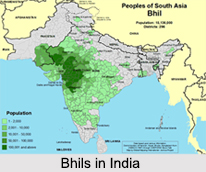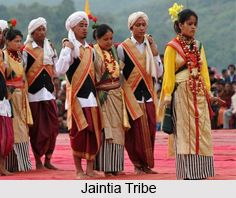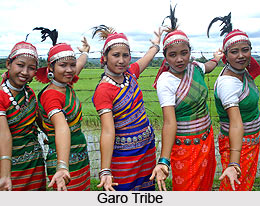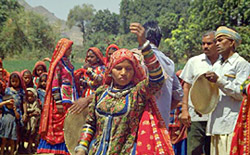Jankor also known as Sarhul is an annual fiesta of the Kharia Tribe celebrated with great enthusiasm and vigour during the month of Phalguna i.e. during February-March. Prior to the commencement of the festival the Kharias begin their preliminary preparations almost ten days. The preparations are initiated by the local priests preparing the Tapawan Golang, a rice beer meant for sacred offering. One day ahead of the festival, the Kharias celebrate the Phagu Katna for which wood is gathered from every Kharia family or neighbouring jungles. These are later accumulated at a particular place outside the village settlement. The priest appointed for the performance of the task remains on fast.
The following day the sacred head along with some young boys of the village travel around their hamlet visiting the different Kharia families with the purpose of collecting fowls and vegetables from them. Subsequently, all the male members assemble at the Jankor Sarna that stores all the collected fowls and vegetables. As per the researches conducted by S.C. Roy, the Kharias offer sacrifices in the name of Khunt and Baghia spirit to propitiate them and to protect the inhabitants and cattle from tiger and bears. However, spirits are not propitiated in this festival that is apparent from the mantras that are recited by the priests during the prayer.
Performance of Jankor Festival
During the celebration of Jankor Festival the priest prepares a hearth consisting of three stone pieces. An earthen pot filled with one litre of cow milk is placed over the hearth. Fire is lit beneath in such a manner that the pot receives heat from all the sides. The Kharias participating in the festival gather around the milk when it reaches its boiling point to observe and monitor the course of the flow of the boiling milk for the first time. The flow is believed to indicate the prospect of the current agricultural year, rainfall or any mishap or misfortune.
It is said that if the boiling milk spills in northern direction, it specifies that there would be better production and rains will be sufficient. If the milk flows in the southern direction, it notifies `salt water rain` that hinders growth in production and the paddy crops being affected by pest. The milk spilling in the eastern side signifies that there would be little rainfall which is however, not sufficient for paddy crop. The milk if spill in the western direction is deemed to be inauspicious. It is indicative of some calamity in the form of pests, locust or draught.
Thereafter, the head priest distributes arwa rice among the people present in the ceremony that is later poured into an earthen pot. The leftover milk of the pot is offered to unmarried boys because they are regarded as sacred and equivalent to the deity.
The priest sits facing the east direction and offers worship to the sacred stone signifying the deity. Water is poured on the stone by his assistant while the sacred head gives bath to the stone for five times. The priest keeps aside five heaps of arwa rice close to the sacred stone. Subsequently, five chickens of varying colours are sacrificed excluding the first one which is allowed to flee in the name of Baghima (Tiger spirit). When a chicken picks up rice grains, it is offered for sacrifice.
The festival thus, celebrated by the Kharia Tribe in honour of their cattle, glorifies their cultural trait and in return help them come close to each other.





















